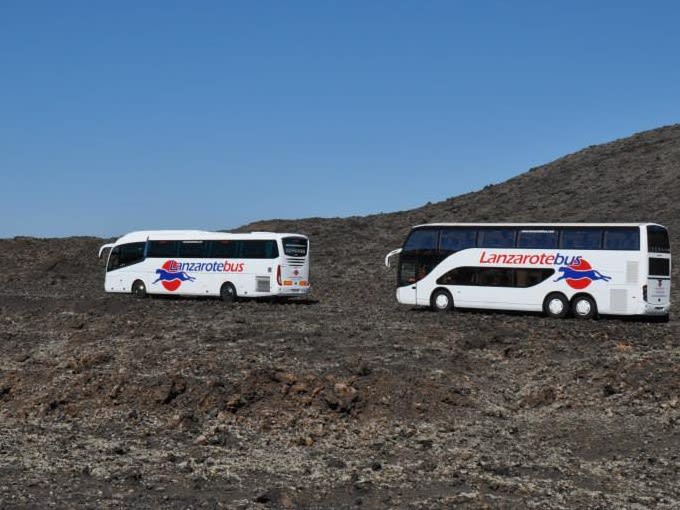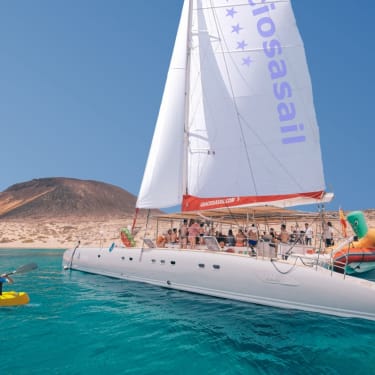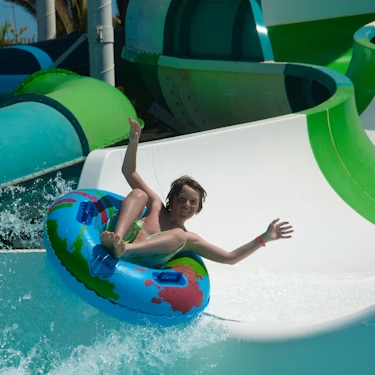More about: Lanzarote in 3 Days: a guidebook for getting the most out of your visit
Are you visiting Lanzarote and don't know what are the best things to do on the island? Then you'll be interested to know that in just three days you can visit the most significant museums and parishes in the historic centre of Arrecife, the Timanfaya National Park, the wine valley of La Geria, the Hervideros, the Janubio salt flats, the island of La Graciosa, Famara beach and the village of Teguise, among other essential destinations.
In this article you will find information about the opening times of each attraction and how to get from one destination to another, as well as a summary of what to see in each one of them.
Day 1: Walk through the streets of Arrecife, the capital of Lanzarote

If this is your first time in Lanzarote, visiting its capital should be one of the first activities to consider in your itinerary. With a walk through its streets you will be able to get to know part of the island's history.
Charco de San Ginés
To start the first day of your stay, you can visit the Charco de San Ginés, located approximately four minutes from the centre of Lanzarote.
It is a natural fishing port with a history of just over six centuries, whose atmosphere will immediately take you back to the time when corsairs and pirates were the main enemies of the island's inhabitants.
El Charco de San Ginés is surrounded by small white houses and shopping streets. My advice is to simply walk around this important port, while enjoying the beautiful natural panorama of the place.
You can also book a boat trip around Lanzarote or just sit on one of the terraces and admire the scenery and take pictures.
San Ginés Parish Church
Just 200 metres away from the previous point you will find the Parroquia de San Ginés, which will be your second destination on your tour of Arrecife.
It is one of the architectural icons of the island, built during the 18th century, rebuilt after a flood and enlarged on several occasions.
When you arrive at this ancient temple you will immediately see the tower in the exterior area, built during 1842, which is perfectly adapted to the neoclassical style of the façade.
You will also notice the incorporation of volcanic stone, which is customary in the town's constructions.
Inside, the Mudejar style of the ceiling and the Tuscan columns stand out. There is also an image of San Ginés de Clermont, who is the patron saint of the island.
Bridge of Las Bolas and the Castle of San Gabriel
Once you have finished your visit to the Parish Church of San Ginés, you should walk approximately 650 metres in the direction of Av. Coll or Av. de Vargas.
In this way, you will reach the promenade, where you will find the historic Puente de las Bolas, which connects with the Castle of San Gabriel, built with the purpose of protecting Lanzarote from North African incursions.
The best thing to do is to walk across the imposing stone bridge, built during the 16th century and with a length of 175 metres. If you look closely, you will see some cannons from the period and a privileged natural panoramic view.
Then you can go to the Castle of San Gabriel, which is currently the headquarters of the Arrecife History Museum, where you will have information about the different historical stages that the island has undergone.
You can visit the museum from Monday to Friday (10:00 to 17:00) and on Saturdays (10:00 to 14:00).
Yellow House
The next stop on your tour of Arrecife is the Casa Amarilla (Yellow House), which is just 350 metres from the Castillo San Gabriel, a five-minute walk at a moderate pace.
There, you can enjoy a series of temporary exhibitions organised by the island's government information system, which houses the Memories of Lanzarote.
This house with its yellow façade, formerly used as the headquarters of the town council, has been preserved and converted into a cultural space that you can access free of charge. You only have to go there from Monday to Friday from 10:00 to 18:00 hours and on Saturdays until 14:00 hours.
San José Castle and the Museum of Contemporary Art
The last destination on the itinerary of this first day in Lanzarote is the Castle of San José, built in the 18th century and which has housed the island's Museum of Contemporary Art since 1976. Inside you will find numerous permanent exhibits and a beautiful view of the bay.
This fortress is located approximately 30 minutes walk or 25 minutes by bus from the Casa Amarilla, so it offers quick access to the historic centre of the city.
To enter you have to pay an average entrance fee of €4. It is open between 11:00 and 18:00. In addition, if you wish, you can stop by the restaurant area to enjoy some traditional food, a drink or a coffee, while you enjoy the scenery.
Day 2: Visit the southern area of Lanzarote

The aim of this day is very simple: to visit as many of the destinations in the south of Lanzarote as possible and fall in love with this beautiful island and visit it again in the future.
The wine valley of La Geria
La Geria is the starting point for the second day in Lanzarote. It is located right at the foot of Timanfaya, in the southwestern part of the island.
You can drive along its roads to see a real volcanic landscape with craters, cacti and beautiful vineyards. You can also stop to explore the region more closely and learn about the history of this land, its wineries and delicious wines.
Among the activities on offer in the wine valley of La Geria you will find:
- Visit the Museo del Campesino, admission to which is free. You can enter from Monday to Friday, from 10:00 to 18:00.
- Wine tasting in the many wineries in the region. For example, El Grifo, which is considered the oldest winery in Spain and in whose building you can see an exclusive museum dedicated to the history of wine. Another option is the Bodega Rubicón, present since 1979....
Timanfaya National Park
Just 18 minutes drive from La Geria is the Timanfaya National Park, a historic natural area of extraordinary beauty.
The first thing that strikes you is the contrasting landscape of the region: wide, desert-like plains, a variety of colours (black, red, orange, ochre), volcanic silhouettes and a series of deep fractures through which the lava from the ferocious volcanoes once flowed.
As one of the main destinations on the island, you will find several excursions to Timanfaya, should you prefer to be taken there.
Once in the park, you will be able to choose between different activities such as a hiking route through this historic park, one of the best buggy tours Lanzarote has to offer or a camel caravan on the slopes of the Macizo del Fuego volcano.
Don't miss the Visitor Centre, which is free of charge. There, you will find a souvenir shop, as well as an elevated walkway where you can walk while enjoying a privileged view. There is also a projection room and an exhibition hall.
Montaña Bermeja Beach
If you are a wave enthusiast, after touring the Timanfaya National Park, you should head to Montaña Bermeja Beach.
This magical place is located approximately 14 minutes away from your previous destination and offers a unique natural landscape to its visitors. There you will see the black sand and the crystalline waters of the sea at the foot of an imposing reddish mountain.
On the other hand, if you plan to slide into these waters with your surfboard, you should bear in mind that the waves in this area are quite strong, so if you are not a professional in this sport, you should refrain from surfing.
However, you should not be discouraged, as there are many tours and excursions from Lanzarote that offer surfing lessons on the island.
Equally, if you don't want to come into contact with the water, you can take a stroll around the area and take advantage of its natural beauty to take some amazing photographs.
The Hervideros
After enjoying the charm of Playa de Montaña Bermeja, you can take advantage of its proximity to Los Hervideros and, thus, contemplate an impressive natural spectacle, in which the protagonists are the sea and the volcanic caves formed as a result of erosion.
You can access this volcanic coast at any time of the day to see the water of the Atlantic Ocean penetrate and impact in these caverns.
There you will enjoy two different types of views, depending on the strength of the waves. On the one hand, you may find the waters calm , giving you a view with varied shades of blue thanks to the reflection generated by the natural sunlight.
On the other hand, on days when the sea is rough, you will be able to see how the water is ejected from the solidified magma cavities, giving you a mind-blowing effect that will make you think it is boiling.
Janubio Salt Flats
23 minutes away from Los Hervidores is the last destination of the day. It is the famous Janubio Salt Flats, which date back to the 19th century and form part of the historical and natural heritage of the island of Lanzarote.
In this area there used to be a lagoon which, due to the volcanic activity of the region, ended up shrinking. Thus, the salt mines were born, where the work of dozens of generations of Lanzarote people is evident , who adapted to the faults of nature to prosper, evaporating the salt water and obtaining the salt for consumption.
Certainly, when visiting the Salinas de Janubio you will be in direct contact with the history of the island and at the same time you will enjoy an amazing view with a significant variety of nuances. All of them, produced by the reflection of the sun on the surface of the pools of water. A natural scenery that you won't be able to resist photographing.
In addition, between 12:15 and 21:00 (except Thursdays) you can go to the viewpoint of the salt pans, a restaurant with a breathtaking view of the region.
There you can sit on the terrace and enjoy a delicious traditional meal. And, if you have travelled to Lanzarote with children, you won't have to worry, because there is a special menu for them.
Day 3: Get to know the northern region of Lanzarote

On the third day in Lanzarote, your itinerary will take you to the northern region. In this part of the island you will find real hidden treasures that will allow you to enjoy a peaceful atmosphere, full of incredible landscapes.
Moreover, if you like water sports, this is one of the best areas to practice them. Finally, you can be part of a cave transformed into a work of art.
La Graciosa Island
An excursion to the island of La Graciosa from Lanzarote should not be missing from your plans. This natural area is located in the Chinijo archipelago and, if you don't want to go on an organised tour, you can access it by ferry from the port of Órzola.
The ferry arrives at Caleta de Sebo, a jetty and central area of this small island. This is a perfect spot to start exploring the place, either on foot or by bicycle, as there is no car hire due to the absence of tarmac roads.
During the excursion to La Graciosa you will come across some of the best beaches on Lanzarote. Such is the case of Playa de la Laja, Playa Salado, Playa Montaña Amarilla and Playa de la Francesa, whose crystal clear and calm waters offer a risk-free experience.
But if what you want is a quiet environment to relax, your place is the Amber beach, which is usually less crowded. You can also go to the Barranco de los Conejos ravine, which is a path approximately 20 metres long where you will enjoy a privileged panoramic view.
Famara Beach
Back in Órzola, your next destination requires you to go by car or public transport (line 9 Arrecife or line 31 Caleta de Famara) to Famara beach.
There, the characteristic fishing atmosphere of the village merges with a lively tourist environment: restaurants, bars and many surfers, who come daily in search of good waves to glide across them on their boards.
There are approximately 6 kilometres of golden sand that merge with crystal-clear waters. All of this is framed by the Peñas del Chache, considered the highest point on the island, with an altitude of 672 metres above sea level.
This beach is a fairly busy place , so you're going to find lots of people (sportspeople, tourists, locals), no matter what day of the week you decide to visit.
You can take a long walk by the sea while admiring the scenery and breathing in the fresh air or lie on the sand in the areas where the tide is low and soak up the sun.
And if you're a water sports enthusiast, you'll have the opportunity to take advantage of the waves for surfing, kitesurfing and bodyboarding. You can also climb the Famara cliff to go paragliding.
Town of Teguise
After your aquatic experience in Famara, take the car (or the route 31 bus) and head for the village of Teguise, a journey of just 31 minutes.
When you arrive in the old capital of Lanzarote you will immediately notice its particular colonial architectural style: houses with white façades and colourful balconies decorated with beautiful flowers.
Moreover, its cobbled streets invite you to stroll through them to discover each one of the historical and cultural treasures of this town.
In this town you can visit the Spínola Palace Museum, where you will find important examples of art that support the history of the island.
You can also visit the parish church of Nuestra Señora de Guadalupe and the Ermita del Santísimo Cristo de la Vera Cruz, which is a small Christian temple, as well as El Castillo de Santa Barbara, built in the 16th century, inside which you will find the ingenious Museo de la Pirateria (Museum of Piracy).
Water Jameos
At the end of your visit to the town of Teguise, your next destination is Jameos de agua, a perfect farewell to your stay in Lanzarote.
To get there, all you have to do is get on the bus on route 9 Orzola and, in approximately 35 minutes, you will be at your destination. This way, you will discover one of the famous works of art of the Lanzarote-born César Manrique, who converted a huge volcanic cave into a house and museum.
I assure you that you will be amazed by the ingenuity and talent present in every detail. In addition, you can enjoy a peaceful natural environment, with an interesting contrast of colours, given by the rocks, the crystalline waters and the beautiful plants.
To visit Jameos del Agua in Lanzarote you have to pay an entrance fee with an average price of 8€. After going down some rock stairs you will reach the so-called Jameo Grande.
There you will find a restaurant integrated into the rocky surroundings and accompanied by a natural lagoon, where there is a species of albino and blind crabs, characteristic of the abyssal pits.
If you cross the lagoon through a small corridor, you will see the Jameo Chico, with some tables and a pleasant musical background. From there you can go up some stairs to a pool with a tropical atmosphere and, further on, you will find the Casa de los Volcanes (House of the Volcanoes).
The latter is a place where you can learn about the history of the island's volcanoes, learn about the eruption process and see geological samples.
Means of transport in Lanzarote

Lanzarote is an island with a very efficient transport system when it comes to getting to the different tourist destinations to visit. However, you should bear in mind that there are some places where you will need a car or simply walk, as there is no road or it is a protected site.
For example, if you go to Timanfaya National Park, Montaña Bermeja beach, the Volcanoes Park and other remote areas in the southern region, you will have to go by car or hire a guided tour by buggy or other authorised means of transport.
The southern region of the island and the cities offer greater access by bus or guaguas to the main sights in Lanzarote, for an average price of €1.40 from 6:00 to 23:00.




